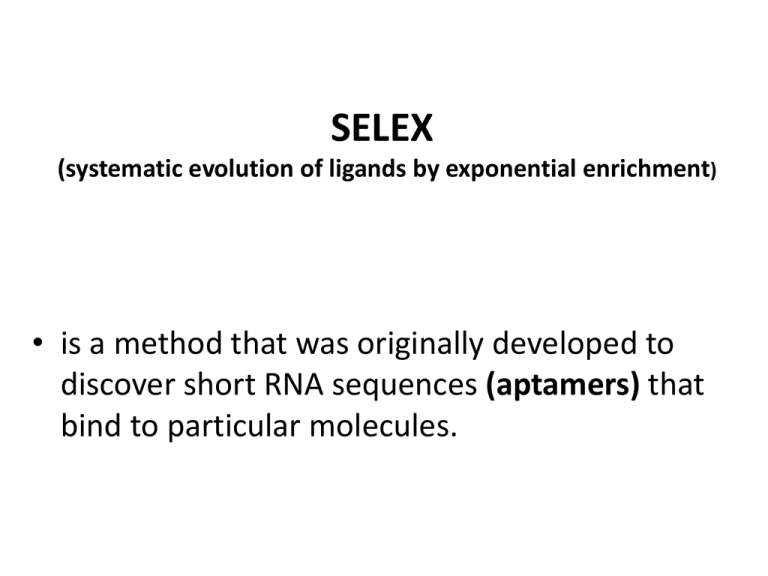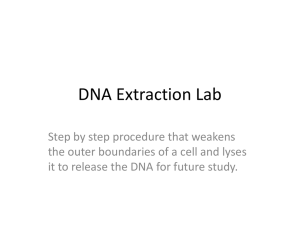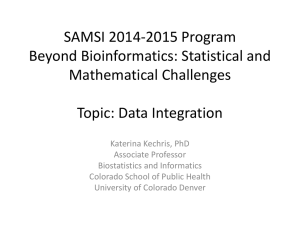Zinc finger nucleases
advertisement

SELEX (systematic evolution of ligands by exponential enrichment) • is a method that was originally developed to discover short RNA sequences (aptamers) that bind to particular molecules. • In the first step: these DNAs are transcribed in vitro, using the phage T7 RNA polymerase, which recognizes the T7 promoter in the upstream constant region of every DNA in the pool. • In the next step: the aptamers are selected by affinity chromatography, using a resin with the target molecule immobilized. The selected RNAs bind to the resin and then can be released with a solution containing the target molecule. These selected RNAs are then reverse-transcribed to yield double-stranded DNA, which is then subjected to PCR, using primers specific for the DNAs’ constant ends. Aptamer • Aptamers (from the Latin aptus - fit, and Greek meros - part) are oligonucleic acid or peptide molecules that bind to a specific target molecule. Aptamers are usually created by selecting them from a large random sequence pool, but natural aptamers also exist in riboswitches. • Aptamers can be used for both basic research and clinical purposes as macromolecular drugs. • More specifically, aptamers can be classified as: • DNA or RNA or XNA aptamers. They consist of (usually short) strands of oligonucleotides. • Peptide aptamers. They consist of a short variable peptide domain, attached at both ends to a protein scaffold. Post-Segregational Killing (PSK) or Toxin-antitoxin system • A toxin-antitoxin system is a set of two or more closely linked genes that together encode both a protein 'poison' and a corresponding 'antidote'. • When these systems are contained on plasmids – transferable genetic elements – they ensure that only the daughter cells that inherit the plasmid survive after cell division. • If the plasmid is absent in a daughter cell, the unstable antitoxin is degraded and the stable toxic protein kills the new cell; this is known as 'post-segregational killing'(PSK). Type I • Type I toxin-antitoxin systems rely on the basepairing of complementary antitoxin RNA with the toxin's mRNA. • Translation of the mRNA is then inhibited either by degradation via RNase III or by occluding the Shine-Dalgarno sequence or ribosome binding site. Example systems Toxin Antitoxin Notes Hok Sok The original and best-understood type I toxin-antitoxin system (pictured), which stabilises plasmids in a number of gramnegative bacteria fst RNAII The first type I system to be identified in gram-positive bacteria TisB IstR Responds to DNA damage LdrD RdlD A chromosomal system in Enterobacteriaceae FlmA FlmB A hok/sok homologue, which also stabilises the F plasmid Discovered in E. coli intergenic regions, the antitoxin was originally named QUAD RNA TxpA/Brn Ensures the inheritance of the skin element RatA T during sporulation in Bacillus subtilis SymE SymR A chromosomal system induced as an SOS response A system identified in Xanthomonas campestris with erratic XCV2162 ptaRNA1 phylogenetic distribution. Ibs Sib Hok sok system Type II • In this system a labile protein antitoxin tightly binds and inhibits the activity of a stable toxin. Type III • Type III toxin-antitoxin systems rely on direct interaction between a toxic protein and an RNA antitoxin. • The toxic effects of the protein are neutralised by the RNA gene. Biotechnological applications • • • • In fermentation As a future target for antibiotics In DNA cloning Control of the Genetically modified organisms Genome editing Genome editing • Genome editing, or genome editing with engineered nucleases (GEEN) is a type of genetic engineering in which DNA is inserted, replaced, or removed from a genome using artificially engineered nucleases, or "molecular scissors." Mechanism • The nucleases create specific double-stranded break (DSBs) at desired locations in the genome, and harness the cell’s endogenous mechanisms to repair the induced break by natural processes of : – homologous recombination (HR) – nonhomologous end-joining (NHEJ). There are currently four families of engineered nucleases being used: – Zinc finger nucleases (ZFNs) – Transcription Activator-Like Effector Nucleases (TALENs) – Clustered Regularly Interspaced Short Palindromic Repeats (CRISPR) – Engineered meganuclease • It is commonly practiced in genetic analysis that in order to understand the function of a gene or a protein function one interferes with it in a sequence-specific way and monitors its effects on the organism. • However, in some organisms it is difficult or impossible to perform site-specific mutagenesis, and therefore more indirect methods have to be used, such as silencing the gene of interest by short RNA interference (siRNA) . • Yet gene disruption by siRNA can be variable and incomplete. • Genome editing with nucleases such as ZFN is different from siRNA in that the engineered nuclease is able to modify DNA-binding specificity and therefore can in principle cut any targeted position in the genome, and introduce modification of the endogenous sequences for genes that are impossible to specifically target by conventional RNAi. Double stranded breaks and their repair • non-homologous end joining (NHEJ) is a error prone process. • Thus if one is able to create a DSB at a desired gene in multiple samples, it is very likely that mutations will be generated at that site in some of the treatments because of errors created by the NHEJ infidelity. Double stranded breaks and their repair • On the other hand, the dependency of HDR on a homologous sequence to repair DSBs can be exploited by inserting a desired sequence within a sequence that is homologous to the flanking sequences of a DSB which, when used as a template by HDR system, would lead to the creation of the desired change within the genomic region of interest. • So based on these principles if one is able to create a DSB at a specific location within the genome, then the cell’s own repair systems will help in creating the desired mutations. Site-specific double stranded breaks • if genomic DNA is treated with a particular restriction endonuclease many DSBs will be created. • To overcome this challenge and create site-specific DSB, three distinct classes of nucleases have been discovered and bioengineered to date: – Zinc finger nucleases (ZFNs), – Transcription-Activator like Effector Nucleases (TALENs) – Meganucleases Meganucleases • Meganucleases, found commonly in microbial species, have the unique property of having very long recognition sequences (>14bp) thus making them naturally very specific. • But the challenge is that: not enough meganucleases are known, or may ever be known, to cover all possible target sequences. To overcome this challenge: • Mutagenesis and high throughput screening methods have been used to create meganuclease variants that recognize unique sequences. Meganuclease advantages and disadvantages. • less toxicity (compared to ZFNs) because of more stringent DNA sequence recognition. • very specific • the construction of sequence specific enzymes for all possible sequences is costly and time consuming. • As opposed to meganucleases, the concept behind ZFNs and TALENs is more based on a non-specific DNA cutting enzyme which would then be linked to specific DNA sequence recognizing peptides such as: – zinc fingers and – transcription activator-like effectors (TALEs) • The key to this was to find an endonuclease whose DNA recognition site and cleaving site were separate from each other, a situation that is not common among restriction enzymes. A restriction enzyme with such properties is FokI. FokI enzyme • The enzyme FokI, naturally found in Flavobacterium okeanokoites, is a bacterial type IISrestriction endonuclease consisting of: – an N-terminal DNA-binding domain and – a non-specific DNA cleavage domain at the C-terminal. FokI dimerization • FokI has the advantage of requiring dimerization to have nuclease activity and this means the specificity increases dramatically as each nuclease partner would recognize a unique DNA sequence. Applications • • • • • • Targeted gene mutation Creating chromosome rearrangement Study gene function with stem cells Transgenic animals Endogenous gene labeling Targeted transgene addition TAL effector • TAL (transcription activator-like) effectors are proteins secreted by Xanthomonas bacteria via their type III secretion system when they infect various plant species. • These proteins can bind promoter sequences in the host plant and activate the expression of plant genes that aid bacterial infection. Transcription activator-like effector nucleases (TALENs) Asparagine Asn N Glycine Gly G Histidine His H Aspartic acid Asp D Isoleucine Ile I Transcription activator-like effector nucleases (TALENs) • Transcription activator-like effector nucleases (TALENs) are artificial restriction enzymes generated by fusing a TAL effector DNA binding domain to a DNA cleavage domain. Transcription activator-like effector nucleases (TALENs) Genetargeting,ontheotherhand,reliesonHRbetweentheendogenoustargetlocusandan exogenously introduced homologous DNA fragment, also referred to as the "donor DNA".In the absenceofaDSBat the targetlocus, typically fewer than1in105 of targetedcellswillcontain the desired genetic modification, a frequency too low to be useful for gene therapy[14]. However, proof‐of‐principle experiments involving the meganuclease I‐SceI, which binds to an 18‐bp recognition site, demonstrated that the insertion of a DSB in the target locus stimulates recombination withanexogenousdonorDNAbyseveralordersofmagnitude[15,16].Aconcernhas been thatNHEJwillcompetewithHR to seal the brokenchromosome.Recentexperimentsin two differenthumancelllinesindicatedthatHR‐mediatedgenetargetingaccountedfor60%to70 %ofall DSBrepaireventsatanendogenouslocus[17],suggestingthatinthepresenceoflargeamoun tsofa donorDNAHRisthepreferredpathwaytorepairDSBs. Zinc finger nuclease • Zinc-finger nucleases (ZFNs) are artificial restriction enzymes generated by fusing a zinc finger DNA-binding domain to a DNA-cleavage domain. • A pair of two ZFNs with three zinc fingers each are shown introducing a double stranded break. Subsequently, the double strand break is being repaired through either homologous recombination or non-homologous end joining. Zinc finger nuclease • DNA-binding domain – The DNA-binding domains of individual ZFNs typically contain between three and six individual zinc finger repeats and can each recognize between 9 and 18 basepairs. • cleavage domain – The non-specific cleavage domain from the type IIs restriction endonuclease FokI is typically used as the cleavage domain in ZFNs. Zinc Finger Nucleases for Genome Editing Types of genome editing made possible using zinc finger nucleases Gateway Technology The Gateway cloning System, invented and commercialized by Invitrogen since the late 1990s, is a molecular biology method that enables researchers to efficiently transfer DNA-fragments between plasmids using a proprietary set of recombination sequences, the "Gateway att" sites, and two proprietary enzyme mixes, called "LR Clonase", and "BP Clonase". Gateway cloning steps • Making Gateway Entry clone • Transfer of target gene from Entry clone into any Gateway Destination vector Entry clones are often made in two steps: • 1) “Gateway attB1, and attB2” sequences are added to the 5’, and 3’ end of a gene fragment, respectively, using gene specific PCR primers and PCR-amplification; • 2) the PCR amplification products are then mixed with special plasmids called Gateway “Donor vectors” (containing attP1 & attP2 )and the proprietary “BP Clonase” enzyme mix. recombination sequences are referred to as the Gateway “att L” type. Destination vector • Invitrogen nomenclature for any Gateway plasmid that contains Gateway “att R” recombination sequences and elements such as promoters and epitope tags, but not ORFs Transfer into Destination vector • The gene cassette in the Gateway Entry clone can then be simply and efficiently transferred into any Gateway Destination vector using the proprietary enzyme mix, “LR Clonase”. To summarize the different steps involved in Gateway cloning: • Gateway BP reaction: PCR-product with flanking att B sites (e.g., amplified from cDNA library) + Donor vector containing att P sites + BP clonase => Gateway Entry clone, containing att L sites, flanking gene of interest – this step can be replaced by other cloning methods • Gateway LR reaction: Entry clone containing att L sites + Destination vector containing att R sites, and promoters and tags + LR clonase => Expression clone containing att B sites, flanking gene of interest, ready for gene expression. Advantages • Fast—1-hour room temperature cloning reactions • Accurate—cloning efficiency >99% delivers the clone you need • Easy—no need for restriction enzymes or ligation to maintain orientations and reading frames for expression-ready clones • Convenient—no resequencing required; use the same clone from target identification to validation for consistency • Flexible—shuttle DNA inserts from one expression vector to the next • Versatile—select from E. coli, yeast, insect, or mammalian cell Destination vectors Building an Entry Clone • The three possible methods that lead to the Entry clone are depicted below: A. BP cloning, B. TOPO® cloning and C. restriction enzyme and ligase cloning.









